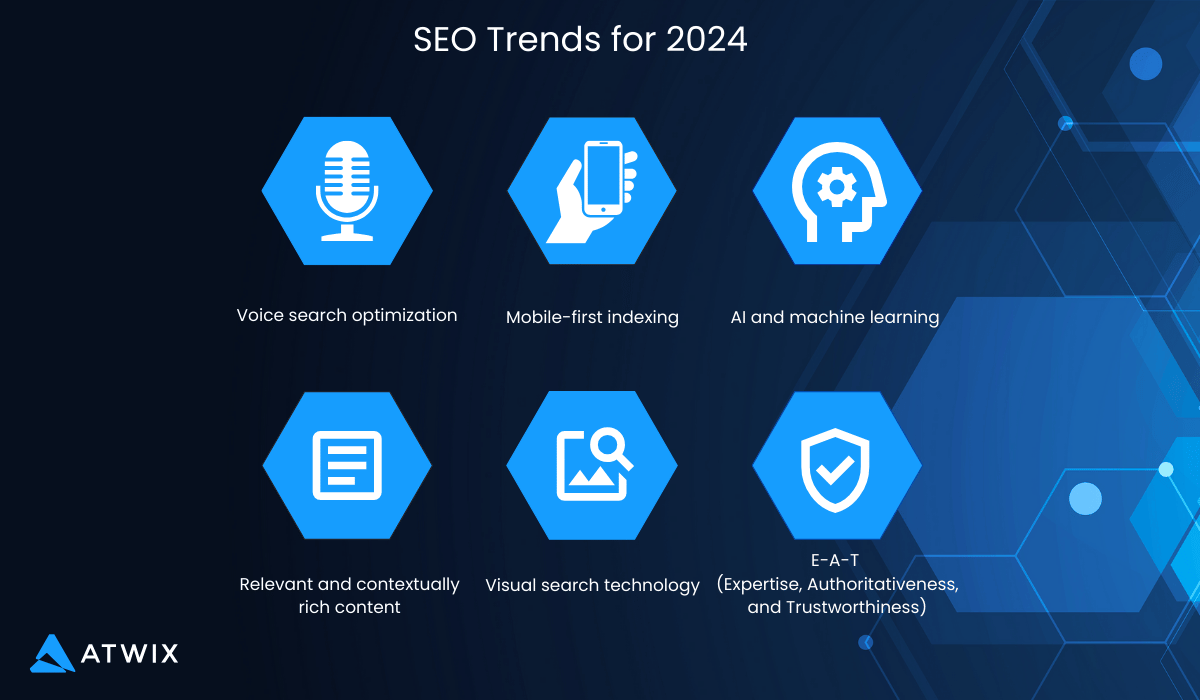As an eCommerce business, you may already know that SEO optimization helps customers find your products online. Every once in a while, it’s still worth looking at the big picture and reviewing your strategy with eCommerce SEO best practices.
SEO optimization is a dynamic and experiment-based field. That’s why checking current trends will help you stay ahead of the competition and keep consistently cutting through the noise and be seen. At the end of the day, organic clicks account for 45.1% of search result clicks, while the top organic search gets almost 20 times the number of clicks that the top paid result gets.
Our 12 best SEO practices for eCommerce include harnessing the power of keywords, enhancing user experience, and leveraging advanced technical strategies, among others. Check out the full list based on the latest trends and Atwix’s rich expertise in Magento SEO. Our journey in digital eCommerce has equipped us with deep insights and proven strategies, and we’re sharing them to help you gain more visibility online.
The Importance of SEO for eCommerce in 2024
Before we get into the specific SEO best practices for eCommerce, let’s briefly overview its main trends. A key thing to keep in mind is that, no matter how good your products are, under 1% of searchers click on the second page of results on Google.
Significant changes in search engine algorithms and user behavior patterns are reshaping how eCommerce sites optimize for visibility and user engagement.
As we move into 2024, a robust online presence is beneficial and essential for any eCommerce business. That’s why the need to stay ahead with the latest SEO practices is more pressing than ever.

The key trends include:
- Voice search optimization, as more consumers are using voice-activated devices for online shopping.
- Mobile-first indexing, reflecting the shift toward mobile browsing.
- AI and machine learning, becoming more integral in refining search algorithms and leading to more personalized and accurate search results.
- Relevant and contextually rich content eCommerce sites should create to stay ahead.
- Visual search technology, changing how consumers find and purchase products. eCommerce sites are adapting by optimizing image content and integrating visual search capabilities.
- E-A-T (Expertise, Authoritativeness, and Trustworthiness) in Google’s algorithm, underscoring the need for authoritative content, especially in niches that impact consumer health and finance.
These trends highlight the need for eCommerce sites to adopt a more dynamic, responsive SEO strategy that goes beyond traditional keyword optimization. Businesses should focus on overall user experience, technical SEO for eCommerce, and content relevance. Understanding and adapting to these changes will be crucial for eCommerce sites to maintain their competitive edge and effectively reach their target audience.
Now, let’s break down some important SEO best practices for eCommerce sites.
12 eCommerce SEO Best Practices
Here are some of the best practices in SEO for eCommerce to keep in mind for 2024.
1. Conduct Keyword Research and Targeting for eCommerce
Keyword research, or identifying the terms and phrases your target audience uses when searching for products or services online, is the bedrock of effective SEO for any eCommerce site.
There’s a reason why keyword research kicks off our list of SEO tips for eCommerce sites. It informs the content strategy and guides the optimization of various elements like titles, descriptions, and prices.
Here is how you should conduct keyword research:
- Understand your customer: Start by anticipating your customer’s needs and language. What are their preferences and search habits? This understanding will inform the type of keywords they are likely to use.
- Identify your keywords: Use tools like Google Keyword Planner, Ahrefs, or Semrush to find relevant keywords. Look for high-volume terms and find ways to compete with other stores.
- Focus on the long tail: Don’t target the most popular keywords only; consider long-tail and more specific phrases. Longer keywords often have lower search volumes but higher conversion rates because they capture more precise user intent.
- Analyze keyword trends: Stay updated with keyword trends. Use Google Trends to see how search queries evolve over time and adjust your strategy accordingly.
- Integrate keywords thoughtfully: Once you’ve identified your keywords, integrate them strategically into your eCommerce website in your product titles and descriptions, blog posts, and meta tags. However, avoid keyword stuffing. Your primary goal is to make the content natural and user-friendly.
- Monitor and adapt: Regularly track the performance of your keywords. Be ready to update your strategy based on shifting trends and new insights to maintain optimal search visibility.

Remember, keyword research isn’t a one-time task. Regularly monitor the market and performance of your keywords. Adapt your strategy based on trends and changing consumer behaviors.
2. Enhance User Experience and Conversion Rates
One key to increasing conversion rates is building a site that enhances user experience and conversion. A website that is easy to navigate, fast to load, and offers a personalized experience ranks better in search engines and triggers more conversions.
Here are some key points to consider:
- Simplify navigation: Ensure your site’s navigation is intuitive. Simplified menus, clear category labels, and a robust search function help users find what they need quickly.
- Optimize for mobile: With a significant portion of online shopping done on mobile devices, ensure your site is fully responsive and mobile-friendly.
- Use Clear CTAs: Employ clear and compelling calls-to-action (CTAs) to guide users toward making a purchase or taking the desired action.
- Personalize user experience: Implement personalized recommendations and content based on user behavior and preferences.
- Streamline checkout process: Reduce cart abandonment by simplifying the checkout process. Offer multiple payment options and a guest checkout option.
- Add live chat support: Provide immediate assistance and improve user engagement with live chat support.
3. Make Website Elements SEO-friendly
Optimizing website elements is crucial for SEO. Clear URLs and alt texts improve user experience and accessibility, while structured data and responsive design enhance your site’s appeal to search engines.
These practices contribute significantly to better indexing, higher search rankings, and improved user experience:
- Craft SEO-friendly URLs: Ensure URLs are clear, concise, descriptive, and include relevant keywords. Keep them straightforward without lengthy parameters. URLs should reflect the page content and be easy for users and search engines to understand.
- Include target keywords: Incorporate relevant keywords into URLs to enhance SEO and give users a clear idea of the page content.
- Use descriptive alt texts for images: Alt texts should accurately describe the image content and context. Include keywords where appropriate, but focus on clarity and relevance to the image.
- Implement structured data: Use schema markup for URLs and images to let search engines better understand and display your content in search results.
- Optimize file names and titles: For images, videos, and other media, use descriptive file names that include target keywords.
- Responsive design: Ensure all website elements, including images and navigation, work seamlessly across different devices.
Crafting SEO-friendly URLs and alt texts is a strategic component of your site’s SEO. Well-structured URLs contribute to better ranking, clearer site architecture, and an enhanced user experience. Here’s a comprehensive list of Magento SEO extensions to optimize your Magento store.
4. Utilize AI for Personalized User Experiences
Implement AI-driven tools to personalize user experiences on your site. AI can analyze user behavior to display personalized product recommendations and content, improving user engagement and SEO.
Possible AI utilizations include:
- AI-based recommendations: Use AI algorithms to suggest products based on user behavior, enhancing the shopping experience.
- Personalize content with AI: Dynamically change content displayed to users based on their browsing history and preferences.
- AI-driven chatbots for customer support: Integrate AI-powered chatbots for efficient customer service and interaction.
- Leverage AI for SEO analysis: Utilize AI tools for deeper insights into SEO performance and to identify areas for improvement.
- Optimize for voice search with AI: Use AI to understand voice search queries better and optimize content for these terms.
Incorporating video content and AI technologies offers a cutting-edge approach to SEO, enhancing user engagement and providing personalized experiences that are becoming increasingly important in the eCommerce sector.
5. Leverage Video Content for SEO
With the increasing popularity of video content, integrating product videos, tutorials, and user-generated content like reviews can boost engagement and SEO. Videos should be optimized with descriptive titles, tags, and transcripts that include your target keywords.
Here is how you can use video content for SEO purposes:
- Create engaging product videos: Develop high-quality videos showcasing products, how-tos, and user guides. Videos can increase the time spent on the site and provide extra valuable content to your text and images.
- Optimize video titles and descriptions: Include relevant keywords in your video titles and descriptions to appear in search engine results.
- Provide video transcripts: Add transcripts to make your video content accessible and searchable.
- Encourage user-generated video content: User reviews or unboxing videos can enhance authenticity and provide original content.
- Host videos on multiple platforms: Besides your site, use platforms like YouTube to increase reach. Embed these videos on your site for additional traffic.

6. Generate Original Content
The originality of your content is common sense, but it’s helpful to refresh its importance with everything you do online. Generating original content is one of the key eCommerce SEO tips, setting your site apart in the crowded online space. Unique, quality content improves your search engine rankings and engages shoppers, building loyalty and trust.
Here are some things to focus on:
- Create unique product descriptions: Write original and engaging descriptions for each product. Avoid manufacturer-provided descriptions that are likely to be duplicated across multiple sites.
- Develop informative blog content: Regularly update your blog with fresh, informative content that adds value to your customers.
- Leverage user-generated content: Encourage and feature unique content from users, like reviews or social media posts.
- Focus on quality and relevance: Ensure that all content is not only original but also relevant and useful to your audience.
- Regularly refresh content: Update your existing content periodically to keep it fresh and relevant.
7. Avoid Duplicate Content
You should check for duplicate content on the website and introduce as much variety as possible in items, elements, and descriptions.
Here are the best practices to eliminate duplicate content:
- Identify and remove repetitions: Use tools like Copyscape to find and remove duplicate content from your site. Unique content is crucial for SEO.
- Rewrite similar content: If you have pages with similar content, rewrite them to ensure uniqueness while maintaining the page’s purpose.
- Use canonical tags: When duplicate content is unavoidable (like very similar product pages, use canonical tags to direct search engines to the primary page.
- Consolidate similar pages: Combine similar pages into one comprehensive page whenever possible to make it more valuable for users and search engines.
- Regularly audit your site content: Periodically check your website for duplicate content and make necessary adjustments.
Eliminating duplicate content is essential to avoid SEO penalties and ensure that each page on your site uniquely contributes to your overall online presence. Sometimes painstaking, this process goes a long way with search engine rankings and improves user engagement.
8. Enable Customer Reviews
The next point in SEO best practices for eCommerce sites is allowing customer reviews. This generates unique content for your website and plays a key role in building customer trust in your company and improving the overall credibility of your eCommerce site.
How to start collecting customer reviews:
- Encourage user feedback: Create opportunities for customers to leave reviews on your products. This can be through automated post-purchase emails or prompts on your website.
- Showcase reviews on product pages: Display customer reviews prominently on product pages to generate unique content and build trust with potential buyers.
- Respond to reviews: So you got some reviews — great! Now, respond to both positive and negative ones to show you value customer input and are committed to improving your service.
- Leverage reviews for SEO: Use schema markup to display review ratings in search results, enhancing visibility and click-through rates.
9. Optimize Google Business Profile for Local Services
If you’re a local business or service, one of the best tips to improve SEO for eCommerce is optimizing your Google Business Profile. This is especially relevant for eCommerce sites that also have physical storefronts or target specific local markets. It improves your visibility in local searches and provides a trusted platform for visitors to learn about and engage with your business.
Here is how to optimize your Google Business profile:
- Claim and verify your listing: Ensure your business is listed and verified on Google Business Profile (GBP). This increases your visibility in local search results.
- Complete and update information: Provide comprehensive and up-to-date information about your business, including address, hours, contact details, and services offered.
- Add high-quality photos: Visuals can significantly impact user engagement, so include high-quality images of your store, products, or services.
- Don’t forget reviews: Similar to your website, encourage customer reviews on GBP and respond to them to enhance credibility and visibility.
- Use local keywords: Incorporate local keywords in your GBP description and posts to improve local search relevance.
- Post regularly: Use the post feature to update customers on new products, offers, events, or other relevant content.
- Analyze insights: GBP provides valuable insights into how customers interact with your listing. Use this data to refine your local SEO strategy.
10. Perform Technical SEO Optimizations
Technical SEO optimizations let search engines find your eCommerce website and let you provide a secure, fast, and efficient user experience.
The following backend improvements significantly impact your site’s visibility and ranking in search results:
- Ensure mobile responsiveness: Verify that your site is fully responsive and offers a seamless experience across all devices. Nearly three quarters of online shoppers buy with their phones.
- Improve site speed: Use tools like Google PageSpeed Insights to identify and fix elements that slow down your site.
- Utilize SSL certificates: Secure your site with HTTPS to protect user data and improve trustworthiness.
- Optimize for crawl efficiency: Structure your website in a way that search engines can easily crawl and index your content.
- Implement structured data: Use schema markup to help search engines understand the content of your pages better.
- Conduct regular SEO audits: Use tools to regularly audit your site for SEO effectiveness and make necessary improvements.
- Optimize sitemaps: Ensure your XML sitemap is updated and submitted to search engines for better indexing.
If you work with the technical side of SEO yourself, check out this Magento SEO checklist for more details.
11. Build Backlinks
Building quality backlinks is a key component of eCommerce SEO. It involves reaching out and creating relationships within your niche and creating content that others find valuable enough to link to.
Here is how to build backlinks to improve your site’s authority and drive relevant traffic:
- Create shareable content: Develop high-quality, informative content like guides, infographics, and articles that naturally encourage backlinking.
- Leverage influencer partnerships: Collaborate with influencers in your niche to gain backlinks from their platforms.
- Guest post on relevant sites: Write guest posts for reputable websites in your industry with your website link included.
- Engage in community forums: Participate in industry forums or Q&A sites like Quora, providing valuable insights and linking back to your site where relevant.
- Monitor your backlink profile: Regularly check your backlinks for quality and relevance. Disavow any harmful or spammy links.
- Perform competitor analysis: Analyze your competitors’ backlink strategies and identify opportunities for your own site.
12. Optimize for Voice Search
Voice search is increasingly important in SEO as the usage of voice-activated devices grows. That’s why this point makes it to this list of SEO best practices for eCommerce. Voice search requires focusing on natural language and understanding how users verbally interact with search engines.
Surprised by this one? Nevertheless, adapting to this trend can position your eCommerce business effectively in the voice search landscape.
Here is how to optimize your content for voice search:
- Focus on conversational keywords: Use natural language and question-based phrases that align with voice search queries.
- Optimize for local searches: Ensure your business information is up-to-date for local voice search queries, especially if you have a physical storefront.
- Create FAQ Pages: Develop FAQ sections that answer common questions related to your products and industry, mirroring how people naturally ask questions.
- Improve site loading speed: Voice search favors fast-loading sites, making page speed optimization more important.
- Utilize structured data: As before, implement schema markup to help voice search devices understand the context of your content.
It’s smart to apply a mix of time-tested principles with trending best SEO practices for eCommerce, like AI and voice search. This way, you’ll make sure your site and your products are as visible as possible on the web.
| No. | SEO Best Practice | Summary |
|---|---|---|
| 1 | Conduct Keyword Research and Targeting | Essential for understanding customer needs, identifying relevant keywords, focusing on long-tail terms, and integrating them strategically across your site. Regularly monitor and adapt. |
| 2 | Enhance User Experience and Conversion Rates | Improve site navigation, mobile responsiveness, CTAs, personalized experiences, checkout processes, and live chat support to increase conversions and rank higher in search engines. |
| 3 | Make Website Elements SEO-friendly | Optimize URLs, alt texts, structured data, and file names for better indexing, higher rankings, and improved user experience. Ensure a responsive design across devices. |
| 4 | Utilize AI for Personalized User Experiences | Implement AI tools for personalized recommendations, content, chatbots, SEO analysis, and voice search optimization to enhance user engagement and SEO performance. |
| 5 | Leverage Video Content for SEO | Create and optimize engaging product videos, tutorials, and user-generated content. Use descriptive titles, tags, and transcripts to boost engagement and SEO. |
| 6 | Generate Original Content | Produce unique product descriptions, informative blogs, and user-generated content. Regularly update and refresh content to maintain relevance and improve search engine rankings. |
| 7 | Avoid Duplicate Content | Identify and remove duplicate content, use canonical tags, and consolidate similar pages. Regularly audit your site to ensure unique content and avoid SEO penalties. |
| 8 | Enable Customer Reviews | Encourage and showcase customer reviews on product pages. Respond to reviews, and use schema markup to improve visibility and credibility in search results. |
| 9 | Optimize Google Business Profile for Local Services | Claim and verify your listing, update information, add visuals, encourage reviews, and use local keywords to improve local search visibility and engagement. |
| 10 | Perform Technical SEO Optimizations | Ensure mobile responsiveness, site speed, SSL certificates, crawl efficiency, structured data, and regular SEO audits for better visibility and ranking. |
| 11 | Build Backlinks | Develop shareable content, leverage influencer partnerships, guest post, engage in forums, monitor backlinks, and analyze competitor strategies to improve authority and drive traffic. |
| 12 | Optimize for Voice Search | Focus on conversational keywords, optimize for local searches, create FAQ pages, improve site speed, and use structured data to better cater to voice search queries. |
Leveraging Atwix’s Expertise as Magento SEO Audit Partners
If all this technical optimization stuff feels overwhelming, we understand it. We’ve been there before we became experts in Magento SEO.
Today, Atwix is an expert team focused on delivering comprehensive SEO audits that identify areas for optimization in Magento platforms. Our deep understanding of Magento’s architecture allows for tailored recommendations to improve SEO of eCommerce websites that align with SEO best practices and the unique needs of each eCommerce business.
Atwix’s role extends beyond audits to guiding the implementation of these strategies, ensuring that every aspect of your Magento site is optimized for maximum search engine visibility and performance.
This specialized approach guarantees that your eCommerce platform is search engine friendly and is positioned for sustained online growth.
Conclusion
Mastering eCommerce SEO in 2024 is about embracing evolving trends and implementing effective practices. Hopefully, this list of eCommerce SEO best practices has been helpful. By focusing on keyword research and user experience and leveraging new technologies like AI and video content, businesses can significantly enhance their online presence.
Utilize these insights and strategies to stay ahead in the competitive digital marketplace and achieve sustained growth for your eCommerce venture.
As your Magento SEO Audit Partner, Alwix offers a comprehensive Magento SEO audit to ensure your eCommerce platform implements all the latest technical best practices.
If you’re ready to transform your digital presence, we’re just a few clicks away. Drop us a line to get started.
Frequently Asked Questions
Got some questions? We’re here to answer. If you don’t see your question here, drop us a line with out Contact form.
How long does it take to see results from implementing these SEO practices?
Implementing these eCommerce SEO best practices can yield noticeable improvements within a few months. However, significant and sustained results, especially in rankings and traffic, can take six months to a year, depending on competition, market dynamics, and other factors.
How crucial is user experience (UX) for eCommerce SEO success?
User experience is vital for eCommerce SEO success. A mobile-friendly, fast-loading site with easy navigation enhances user satisfaction and boosts search engine rankings.
How can I find the right keywords for my eCommerce site in 2025?
To find the right keywords in 2025, use tools like Semrush or Ahrefs to identify long-tail terms and trending phrases that match user intent. Regularly review and adjust to stay competitive.
What’s the difference between eCommerce SEO and regular website SEO?
eCommerce SEO focuses on optimizing product pages, category structures, and conversion-driven elements, while regular SEO typically emphasizes informational content and broader keyword strategies.
How can SEO help increase repeat purchases on my eCommerce site?
SEO can help increase repeat purchases by enhancing your site’s visibility for returning customers through strategies like personalized recommendations, optimized loyalty program pages, and email retargeting campaigns. Additionally, improving site navigation and user experience encourages customers to return and complete additional purchases.
What are some quick SEO improvements I can make to boost holiday sales?
Quickly boost holiday sales by optimizing landing pages with seasonal keywords, updating meta tags, ensuring mobile responsiveness, and highlighting promotions with structured data.
